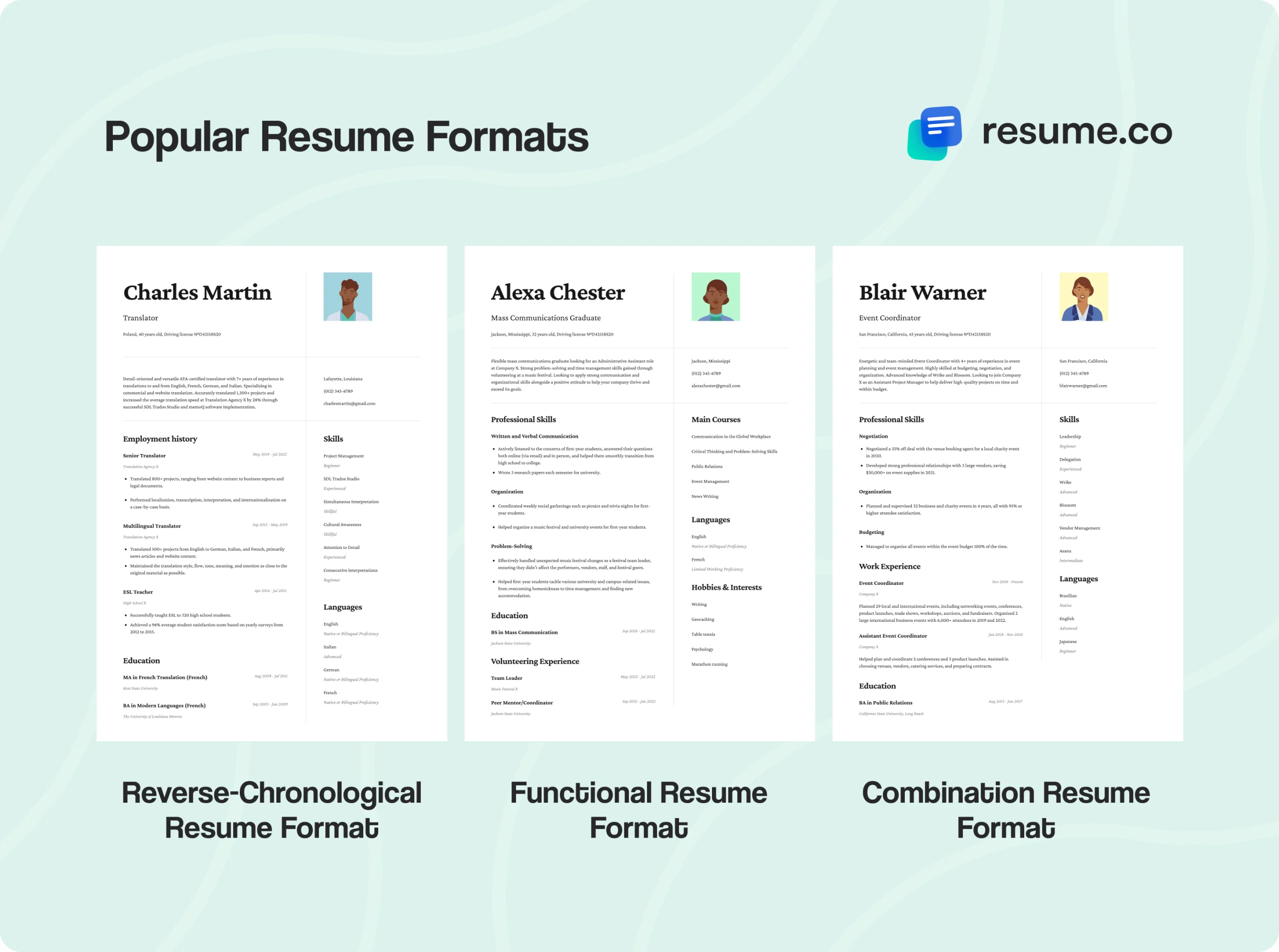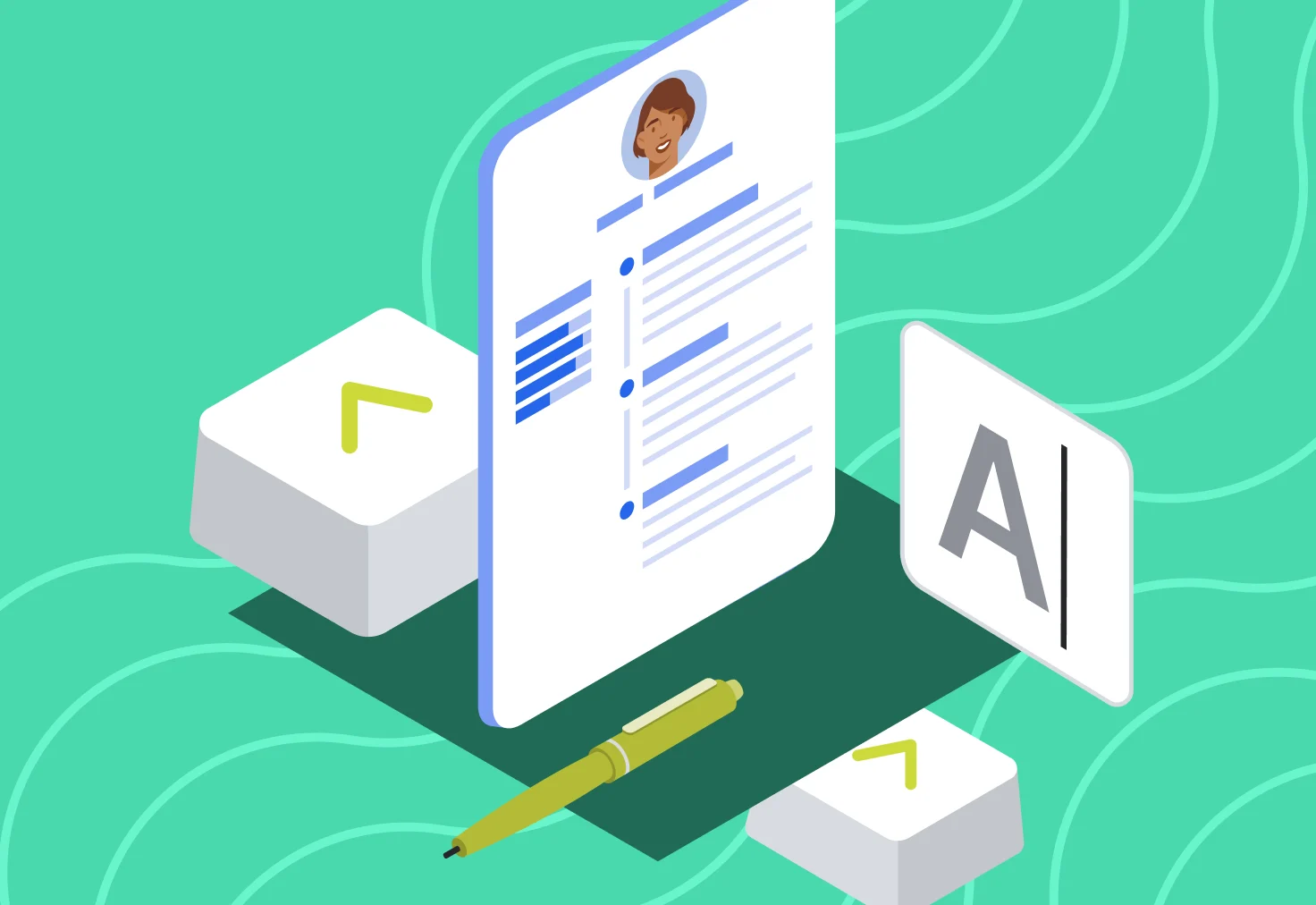As a bartender, you know how to make dozens or even hundreds of different drinks by heart. So, what’s one more recipe to add to the list? This one, however, is quite a bit different from the rest, and it’ll teach you how to make an intoxicating bartender resume.
Set your strainers, muddlers, jiggers, and bar spoons aside and put your thinking hat on.
We’re about to dive deep into the subject and learn all there is to know about crafting an impeccable bartender resume. Without further ado, let’s jump right in!
Key Takeaways
Most candidates will get the best results with a one-page resume written in reverse-chronological format.
Your contact information, resume objective or summary, work experience, education, and skills are must-have sections on your bartender resume.
In addition to bartending skills, new bartenders should showcase their customer-relation and people skills, while experienced ones can highlight their leadership and management abilities.
Optional sections like courses and awards, languages, hobbies, and interests can help you personalize your resume and tailor it to the specific position you’re applying for.
What is the Right Format to Use for a Bartender Resume?

Before we start with the specifics, we need to figure out which format will work best for your bartender resume.
There are many resume formats to choose from, but three have been proven time and again to yield the best results. They are:
Common Resume Formats
Chronological
Functional
Hybrid

By far, the most common resume format is chronological. It lists your previous jobs and achievements in reverse-chronological order, which is a preferred method by recruiters. Also, that kind of orderly information organization makes this format ATS-friendly.
A functional resume format is recommended for entry-level candidates who lack work experience, as it emphasizes skills instead.
A hybrid or combination resume format is perfect for seasoned veterans in the field. It lets you show off your excellent skills and backs up each skill with relevant professional achievements.
Resume templates
Resume templates that are designed to help you win a jobResume Layout
A resume's layout determines how your document will look.
How many times have you heard a customer say, “I want this drink because I like how it looks”?
That’s the effect you want your bartender resume to have on recruiters. Here are some guidelines to help you achieve it:
Resume Layout Guidelines
You should keep your resume one page long since most recruiters often spend just a couple of seconds skimming through resumes.
To ensure you’ve conveyed a lot of information in a concise way, you should use bulleted lists instead of blocks of text.
Choosing a clean and professional font for your resume (e.g., Calibri or Verdana) will make it more readable.
You can start with 1-inch margins on all sides, 10–12 pt font size for text, 14–16 pt font size for section headings, and moderate white space between sections, and then adjust these values until you get a good-looking resume.
What Sections Should a Bartender Resume Contain?

These sections represent a staple of any bartender resume:
Mandatory Resume Sections
Contact Information
Resume objective/summary
Work experience
Education
Skills
And here are some optional sections that you can use to add flavor to your resume and make it unique:
Optional Resume Sections
Courses and awards
Languages
Hobbies and interests
These are all ingredients used to create a spicy bartender resume, and we’re about to explore how to do each one of them. However, if you’d like to speed things up, you’re welcome to use our resume builder.
It’s a software tool that features professional layouts where you can get a finished resume in minutes by filling in the blanks with your information. Not only that, but you can change the looks of an entire resume—its font, colors, and more—with a single click.
Bartender Resume Template
To show you just how powerful and versatile our resume builder is, here’s a bartender resume template you can make with it in minutes:
Bartender Resume Template
Name and Surname
Phone number: 000-000-0000 | Email: namesurname@gmail.com | Location: City, State
[Adjective] [your job title] with [years of experience, if applicable] in [your area of expertise, if applicable] looking for a [position] job at [company name]. Eager to apply [relevant skills] gained through [work/volunteer/other experience] to help [company name] [mention what you can do for the company].
Skills Summary
Skill #1
Mention any achievements relevant to this skill
Explain how you used this skill
Explain how you used this skill
Skill #2
Mention any achievements relevant to this skill
Explain how you used this skill
Explain how you used this skill
Skill #3
Mention any achievements relevant to this skill
Explain how you used this skill
Explain how you used this skill
Work Experience
Most Recent Relevant Job Title Company City, State[Start date] — [End date]
For recent jobs, use 5-6 bullet points to list your top achievements and responsibilities
Use action verbs to make your responsibilities and achievements stand out
Add numbers to quantify your achievements
Less Recent Relevant Job Title Company City, State[Start date] — [End date]
For recent jobs, use 5-6 bullet points to list your top achievements and responsibilities
Use action verbs to make your responsibilities and achievements stand out
Add numbers to quantify your achievements
Education
[Degree] in [Major][University/college name][Start date] - [Graduation date]
Additional Sections
Add any relevant additional sections if you have space (soft and hard skills, languages, licenses, publications, etc.)
Bartender Resume Contact Information

If you create a captivating resume, recruiters will likely contact you for an interview. For them to be able to do that, you need to put your contact information in your resume’s header.
It’s a simple section that should feature the following:
Mandatory Contact Information
Your name
Job title
Phone number
Email address
LinkedIn (optional)
Location (optional)
Here’s what that looks like in practice:
Contact Information Section Example
Gerald Cain Bartender + 765 257 9808 geraldcain@example.com linkedin.com/in/geraldcain22 Indianapolis, IN
You want to keep this section sharp and professional. That means no witty job titles and no silly email addresses.
Lastly, make sure to proofread everything. It would be a shame to lose your chance of landing a job over a misplaced phone digit.
Bartender Resume Objective or Summary

You could spend hours perfecting your bartender resume, only for recruiters to skim through it in a matter of seconds. And since you don’t want that to happen, your resume needs to start with a strong opening in the form of a resume objective or summary, which is a short description of your resume.
New bartenders should write a resume objective to talk about their skills and ambition.
Bartenders with a lot of experience can get the attention of recruiters with a resume summary that highlights their most important accomplishments.
Bartender Resume Objective
When writing a bartender resume objective, you should use 2–4 sentences to highlight your abilities and show motivation.
Here’s one way of doing that:
Resume Objective Example
Passionate people person and mixology devotee looking for a bartender role at [your bar]. Looking to satisfy customers and leave them with lasting, memorable experiences. Relevant experience includes waitering at an [ABC Restaurant]. Adept at making cocktails, serving beverages swiftly, and maintaining a bar.
And here’s how not to write a resume objective:
Bad Example
New bartender looking for work to improve my skills and learn new cocktail recipes.
Bartender Resume Summary

Similarly to an objective, a bartender resume summary should also be 2–4 sentences long, but it should be about your most impressive work achievements.
Let’s see that in an example:
Resume Summary Example
Dedicated bartender with 5+ years of experience creating appealing concoctions for customers at more than 10 bars across Miami. Notable achievements include exceeding sales targets by 11% at [XYZ Bar] utilizing vast cocktail knowledge coupled with a personable approach. Seeking to join your establishment and provide the highest quality service.
Notice how the candidate talked about specific results to create an eye-catching resume? Compared to it, the following example looks absolutely bland and completely uninspiring:
Bad Example
Energetic bartender with years of experience mixing and serving drinks looking for work.
Bartender Resume Work Experience

A good work experience section could single-handedly make you stand out among the competition, so let’s see how to make it flawless.
General Tips
Let’s start with the fundamentals. When you list a previous job, you should include the following:
Position name
Company name
Dates of employment
Responsibilities and achievements
Of course, you can do much more than just add these and call it a day.
Remember those bullet lists we mentioned when we talked about a resume layout? You should use them to talk about your responsibilities and achievements. 3–5 points for each previous job is a sweet spot.
You can make them more prominent by adding memorable action verbs and power words such as “delivered” or “assisted” instead of “gave” or “helped.”
Furthermore, by including numbers and statistics, you’ll give your accomplishments more weight and make them more impressive.
Little to No Bartending Experience

To easily get a bartending role with no prior bartending experience, you should show that you have people skills and experience in customer service.
Here’s how a candidate leveraged their previous job as a sales associate to create a compelling work experience section:
Little To No Bartending Work Experience Example
Work Experience
Sales Associate Clothes Co San Francisco, CA
March 2021–June 2022
Maintained knowledge of complete inventory and arranged displays 5 times a week.
Modernized loyalty membership features and perks to reduce cancellation rates by 11%.
Outperformed sales goals in the 4th quarter of 2021 by 9% through a customer-first approach.
Experienced Bartender
As an experienced bartender, you can use this section to show more than just your bartending skills. You should use the opportunity to highlight your leadership and management experience as well.
Here’s a good example:
Experienced Bartender Work Experience Section Example
Work Experience
Bartender Fizo’s Bar New York, NY
September 2018–Current
Invented 20+ unique recipes based on past experience and customer desires to drive sales up by 7%.
Onboarded 5 new employees and trained them to deliver exceptional customer service.
Optimized alcohol storage temperatures to save more than $3.5k in losses per year.
Bartender Resume Education Section

You don’t need a degree to get a bartending job, but it can help add credibility to your resume, especially if you’re an entry-level candidate. It’s also beneficial if you have a degree in related fields such as communication or culinary arts.
Your education section should follow this format:
Education Section Format
Your degree
Institution that issued it
Dates of attendance
List of achievements, relevant courses, extracurricular activities, projects, etc.
Education Section Example
Education
Bachelor of Arts in Communication Georgetown University, Washington, DC 2015–2019
Relevant coursework: Audiovisual Communication, Business Communication, Communication Management
Even if you’re still studying, you could list your degree and either put “current” instead of a graduation date or add “expected” next to it.
Bartender Resume Skills

Specific skill sets are what sets one bartender apart from the other.
Do you have more than 100 cocktail recipes memorized? Maybe your communication is top-notch, or you can take care of dozens of orders quickly and without a hitch.
Your bartender resume skills section is where you show off and convince recruiters you’re the right person for the job.
One of the best approaches to writing this part is to first figure out which skills matter most to your future employers. You can do that by researching the job ad and the establishment you’re applying to.
Once you make a list, you can do more with it than just add it to the skills section. You should mention some of your vital skills next to relevant achievements in your objective, summary, and work experience sections to make them more concrete.
Bartender Skills List
Here are some of the most sought-after bartender skills:
Food and wine pairing
Cocktail recipes
Barware and equipment
Beverage suggestion
POS and credit card terminals
Physical endurance
Great memory
Problem-solving
Teamwork
Time-management
Multitasking
Decision-making
Communication
Leadership
Bartender Resume Optional Sections

Here are some optional sections to help you spice up your bartender resume.
Courses & Awards
Listing relevant courses and awards in your resume is a great way to show dedication to the craft.
Courses add credibility to your skills and show that you strive to learn and perfect your abilities.
Awards show that you’ve achieved outstanding results.
Both of these can make your resume pop.
Languages
Communication is crucial when you’re working as a bartender. More often than in many other professions, you might need to converse in foreign languages, which is why this section is important.
Even if the job ad doesn’t ask for proficiency in foreign languages, this is still a strong section that you should add if you have room on your resume. To do that, list languages based on your skill level, starting with the highest one.
Hobbies & Interests
You can add a healthy dose of personality to your resume with a simple sentence or a list of a few hobbies and interests. This is where you get to show who you are—a person of passion and enthusiasm.
Should You Submit a Cover Letter With Your Bartender Resume?
If you want to show diligence and a willingness to go the extra mile right off the bat, submit a personalized, position-specific cover letter that matches your resume.

Cover letter templates
Create a cover letter by filling in a free template and sharing it for freeA bartender cover letter should generally be 3–5 paragraphs long. You should use it to go into greater detail about your bartending skills and experience, further enticing recruiters to check out your resume.
Bartender Resume Tips
To put a cherry on top of this complete guide, here are some expert tips to help you perfect your bartender resume:
You should put more emphasis on your bartender-specific skills (e.g., drink recipes or beverage suggestions) while only listing a couple of the most sought-after people skills (e.g., communication, teamwork, etc.).
Ensure that your resume is mistake-free and, if possible, ask a friend to review it before you submit it. It can’t hurt to have a fresh pair of eyes look at it.
Unless the job ad states otherwise, you should submit your resume in a PDF format to make sure its layout stays uniform on any device.
You can make links to your email address and LinkedIn profile clickable in your contact information section. That shows attention to detail and makes it easier for recruiters to contact you or check out your LinkedIn.
Lastly, before you get started writing your own resume, check out this professional bartender resume example for guidance and inspiration.
Closing Thoughts
There you have it! All the ingredients are there, and you’re ready to start mixing. Or, in other words, you are now perfectly capable of creating an exhilarating bartender resume from scratch.
Whether you decide to make one from scratch or use our resume builder (which can really do most of the heavy lifting for you!), we hope that this guide has helped you get a better understanding of what recruiters are looking for in candidates for this type of position. All that remains is to turn all the theory into practice and get closer to that job!
Related Articles
Waiter Resume Example & Writing Guide Server Resume Example & Writing Guide Chef Resume Example & Writing Guide


